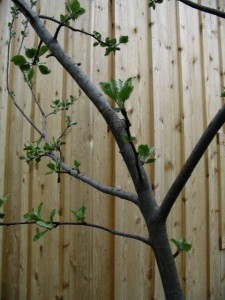This week we ordered a couple new fruit trees for the 20minutegarden — I just love garden work I can do while wearing slippers and sipping a cup of tea. We have been working slowly and steadily to build a small scale urban orchard for several years. This year it was time to add a couple more trees now that we’re pretty comfortable with the overall shape of the garden. Our first advice is to carefully observe your yard and don’t rush into things. It’s far easier to transplant a rogue perennial than a mis-planted apple tree.
Our selection process focused on choosing the best kind of tree for us and deciding on the optimal spots in the yard. And it went without saying that we’d buy good stock from a reputable dealer. A tree will be a feature of our yard –and nearly a member of our family– for decades so it didn’t make sense to save a few bucks for a short-sighted bargain. We have had good luck with Trees of Antiquity; their catalog and website provide the right information for making decisions about fruit trees for the home orchard.
We’ve been scoping out spots for a couple years now. Your yard of course will have different considerations, but we tried to consider the effect of the trees’ roots, branches and leaves. As far as roots, we didn’t want to plant TOO closely to the foundation of either the house or the barn (foundations can alter the pH of the soil too). Similar concern for the branches since our first tree regularly sends out its loving arms toward the side of the barn. The effect of the leaves had two kinds of concern. First we wanted a spot where the leaves would get as much direct sunlight as possible; in particular, we tried to avoid structural shade caused by neighboring buildings. The other concern was what kind of shade the trees would cast at their prime. I don’t want shadows. Since I am a somewhat lazy gardener, I would prefer that as many of the leaves as possible fall right on top of the beds where I am going to rake them anyway. We knew this year that we could add two more trees.
We already have a Roxbury Russet apple that predates the construction of the barn. We selected that tree because it was one variety that was somewhat difficult to find at the Ann Arbor Farmers’ Market (though Wasem‘s usually has them in the late fall, unless they sell out.) It’s also an heirloom variety that we absolutely love to eat.
But apple trees like companionship so we ordered two other trees that
1) will bloom at the same time of the season, in this case, late
2) will thrive in our climate zone. It’s possible to coddle and coax a creature to grow outside of their home climate, but even when they live, I sense their hearts are pining for elsewhere.
We wanted semi-dwarf stock so that the tree will be more compact that a full-sized apple tree. We had enough room that we didn’t want to go with a dwarf stock that would always require staking.
We decided to order a Hauer Pippin tree and a Newtown Pippin tree. Both are hardy for our zone and will bloom late in the season along with our Roxbury Russet.
If you are thinking of adding apple trees or other fruit to your garden, take these ideas into account:
* Give yourself time to plan. You may be able to purchase a tree for this year (although some varieties will already be sold out), but one season does not make that much difference. Instead, take a year to monitor and observe your yard. Study the sun patterns to see how many hours your yard actually gets and where.
* Take time to learn. Read up on your chosen fruit trees so you know what to expect in terms of time to fruiting, pollination requirements, tree size, pruning, and pest control. If your selection isn’t self-pollinating (and many fruit trees are not), you will want to plant another one, unless you or a nearby neighbor already have a compatible variety growing.
* Shop with a reputable nursery. Cheap isn’t best with fruit stock. Find a nursery here or online that will teach you about your options so you can make a smart decision.
* Plant it right. We’ll have tips and photos on planting when we get to that step.
* Cultivate patience. Planting a fruit tree isn’t a quick road to home-made fruit pie. It’s an opportunity to think about the long haul and the future.
Martin Luther was quoted as saying, “Even if I knew the world would end tomorrow, I would still plant a tree today.” Even if you can’t imagine living in your present house in ten years from now, someone will. Consider planting a fruit tree for them.



